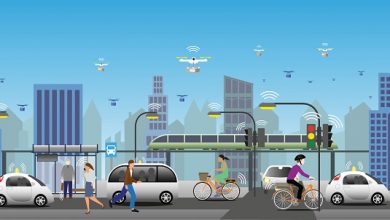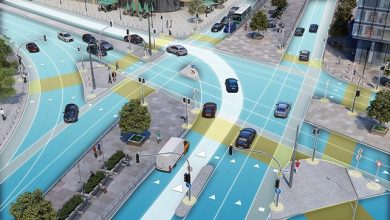Making shared mobility smarter
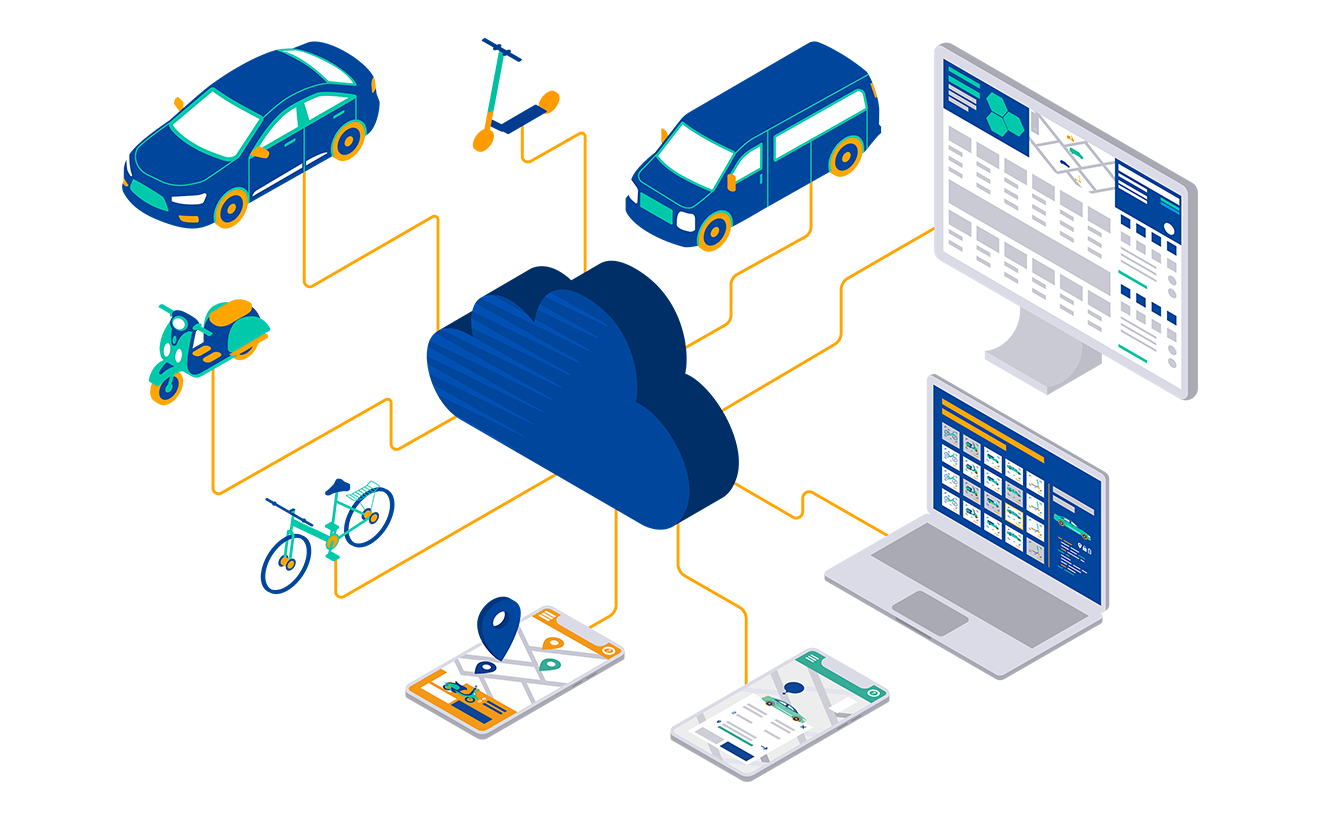
Think of a destination and ask yourself how you’ll get there. Until fairly recently, the answer would broadly fall into two camps – using privately owned methods of transport such as one’s own car, scooter or bike – or taking public transport. But recent years have seen the hybrid model of shared mobility emerge as an increasingly viable choice. The arrival in the world’s cities of fleets of shared mopeds, e-scooters and fleets of free-floating cars available for spontaneous rental has seemingly occurred overnight.
Analysts watching this trend are certainly describing growing momentum. McKinsey notes that the shared mobility market “exceeds $60 billion in value across the three largest markets: China, Europe, and the United States”, anticipating annual growth exceeding 20 percent through 2030. As to India, P&S Intelligence expects the shared mobility market to even witness a massive annual growth of 56.8 percent between 2020 and 2025. In terms of form factors Berg Insight projects for car sharing that membership of such schemes will grow at 21.5 percent from 71.9 million members at the end of 2020 to 190.3 million by 2025. Meanwhile, the nascent moped – or scooter – sharing industry saw even faster growth – with analyst Enrico Howe from mopedsharing.com recording a 58 percent growth in the global fleet of shared vehicles last year – albeit that the overall number of 104,000 mopeds reflects the relative youth of this sector.
At Invers, we see this growth accelerating but with the knowledge that this is a story that’s decades in the making. Invers pioneered automated vehicle sharing in the early 1990s in Germany. Inspired by the idea that young people averse to car ownership could buy a car together and share it for their occasional trips, our founder Uwe Latsch applied an engineering solution and created a system to simplify the process of sharing cars. With a telematics unit installed in the car, Invers made developments like digital handover possible. However, these first services predated the real breakthrough – the ubiquity of mobile technologies that would make car sharing a truly seamless, convenient and easy experience. Over two decades, we helped make this possible – for example by enabling the first free-floating car sharing services. Today, with reliable telematics and customisable software solutions for fleet data and telematics management the company has worked with customers in more than 50 countries to power more than 350 shared mobility projects. We are enabling everything from cars and campers, to mopeds, kick-scooters, and e-bikes to be shared.
Shared mobility is yet to hit the mainstream
Despite our own successes and the global ramp up of adoption of shared mobility services in general, we must concede that these services are still far from reaching mass adoption. In much of the world, the majority of trips are still made by a private vehicle: In some markets, car ownership is still cheap enough to reduce consideration for alternatives like shared mobility services. Elsewhere, like here in India, private mopeds/scooters are also still the preferred choice.
The world over, many of the shared mobility services that have launched or expanded into new markets have struggled to sustain growth or profitability – in some cases rolling back services or retreating to core markets. Following a particularly torrid 2019, Strategy Analytics’ Roger Lanctot noted in a scathing blog that in many cases these were self-inflicted wounds, caused by services that were “crappy and unreliable” with unpredictable and poor customer service, and business models that at times piled “high operating costs onto lousy execution”. Ouch. Even so, Lanctot concluded that one would be completely wrong to write off the sector, pointing to efforts to right these wrongs by established operators that were resetting their businesses and by new entrants bringing new perspectives. Indeed, despite the uncertainties of COVID 19, the past year has seen shared mobility continuing to attract attention, investment and – most importantly – experimentation. A key trend has been to offer more services that better reflect customer needs, with services increasingly offering improved choice through mixed fleets that combine multiple vehicle brands and different form factors too.
Major automotive OEMs such as Citroen and Renault launched purpose-built electric vehicles developed specifically with shared mobility in mind, with Renault anticipating similar demand with the EVs developed for its Mobilize brand. These are important steps – offering the right choice of vehicles for the rigors of sharing makes sense: the utilitarian, rugged design of models like the Citroen Ami and Dacia Spring better reflects the often-tough life of shared vehicles. Additionally, vehicles that are purpose built for sharing will often come with specific features required for sharing that consumer offerings may lack. However, vehicle choices can also be about catering to diverse tastes: For example, BMW and Daimler joint venture SHARE NOW recently added Fiat 500 to its fleet to provide style-forward city cars alongside its existing range of premium cars.
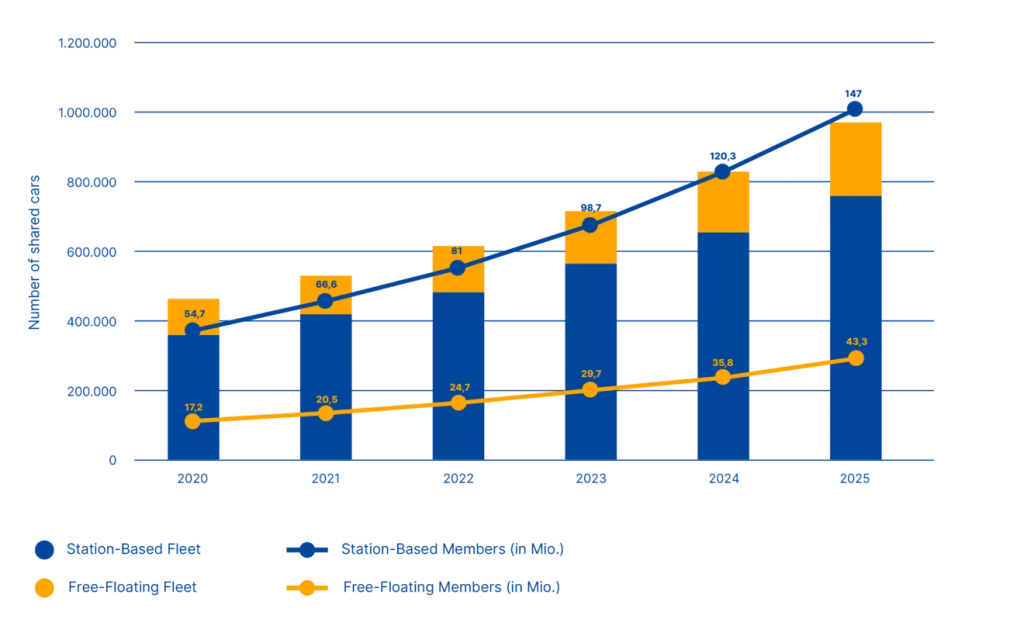
New form factors can be an important way for shared fleets to provide the right type of vehicles for different types of journeys. Operators are expanding their offerings with EVs, but also providing mopeds, kick-scooters and bikes as well. Today, the likes of Lime, Revel and Tier are all now offering multiple vehicle types. Indeed, shared mobility is becoming more broadly understood in terms of offering the right vehicle at the right time – and even the best combination of vehicles to allow for “multi-modal” journeys.
While it’s critical to have an attractive mix of vehicles, there remains a need to integrate, maintain and guarantee the reliability of services. Herein lies the challenge: Adding more brands and form factors adds further complexity, from initially in-fleeting new vehicles to managing the fleet and offering a consistent and consistently reliable service. To stay profitable, all this must be achieved while keeping costs in check.
The role of the shared mobility technology stack in ensuring reliability
When considering reliability, vehicles are only one of several key components of a shared mobility business that must be considered. Just as critical is the technology stack comprising telematics and connectivity, software for fleet data management, and the apps for sharing and booking.
At Invers, we think that the technology stack is where the real opportunities lie for enabling new business models and optimising existing ones. We like to say that “the money is in the code”. As well as reliable service, both revenue streams and costs are ultimately downstream of the data – and the developers able to analyse that data, generate actionable insights and optimise the services accordingly. This is the key to rapidly piloting and testing new customer offers or for designing safer services. A great example of this potential is in driving analysis – where customers could be offered bonuses for good driving practices or have service limits imposed for reckless behaviour.
Indeed, this level of analysis is possible today. imove, Norway’s EV subscription service and an Invers customer, conducts more than 200 analyses to evaluate key fleet indicators such as utilisation, financial performance and customer fluctuation to optimise its service. imove also conducts vehicle lifecycle analysis to determine when a vehicle should be used, for what type of rental, and when it should be removed from the fleet. Hans Kristian Aas, CEO and Co-Founder of imove explains that “the data-centric approach is the secret to our success,”, noting that the ability to use Invers’ technology to reliably deliver a wide range of vehicle data allows imove to offer “the most holistic and forward-looking solution on the market today.”
In the age of mixed fleets, it is also increasingly important that operators have a flexible platform that is vehicle- and telematics-agnostic to simplify the integration of new vehicle types and form factors. This provides the flexibility to select the best vehicles for a great physical experience and a high level of cost efficiency irrespective of technical restrictions. This is especially important as operators expand into new markets and need to adapt their fleets to local preferences, laws – or even geography. For example, operators have discovered that a hilly location like Barcelona will require more powerful mopeds than Berlin or Hamburg.
With a more sophisticated understanding of the strategic importance of technology, operators have increasingly shed the start-up mentality that everything must be built from scratch in house. Today, the drive towards greater reliability, sustainability and profitability is seeing operators take a strategic view on where best to focus in-house development resources to enhance their services, differentiate from competition and grow the business, and which areas can be outsourced to specialists able to deliver proven solutions cost-effectively.
The key recommendation in this build or buy decision is for operators to identify core areas that let them differentiate themselves through unique customer experiences and those that are ‘hygiene’ factors that must be done well but don’t need to be proprietary. Core areas include developing a strong vehicle and trip experience, making it easy and simple to use the booking app, and setting up custom pricing and offers tailored to the customer.
By contrast, basics such as driver’s license verification, payment processes, and telematics connectivity are mission-critical factors that don’t differentiate one service from another on a large scale. As a result, it may make sense to choose a proven third-party provider to outsource these components to while focusing in-house developer resources to innovating the core business differentiators.
Let’s take a quick look at three examples of this build vs. buy decision in action from our own customer experiences:
- MILES, a German-based carsharing service, offers a unique pricing structure to their customers. Instead of the standard per minute billing, they offer pricing by the mile. In addition to this unique pricing model, MILES also wanted to go the extra mile and further differentiate themselves from the market through a better user experience. They opted to develop their sharing software and booking app in-house. For vehicle telematics and connectivity details they rely on Invers. With this approach, MILES was able to provide an enhanced customer experience, achieve breakeven in 2020, and add EVs to their fleet.
- Cooltra, is one of the leading scooter sharing operator in Europe with over 8,500 electric scooters in six countries. To operate more efficiently and scale faster, Cooltra decided to to use Invers’ technology. With shared electric scooters, uptime largely depends on battery levels and usability. One of Cooltra’s key processes is battery swapping and any time saving for this process is a must. With Invers the swapping process can be done with no need to shut down and reboot the telematics unit, something that could otherwise take up to 5 minutes per scooter. Improving the efficiency on a process that is being repeated thousands of times per day has a direct impact on productivity, something that Cooltra considered a key factor when choosing Invers as a partner.
- As mentioned earlier in this piece, SHARE NOW, a carsharing joint venture between Daimler and BMW, chose to integrate Fiat 500s into their fleet to grow their customer base by offering a wider range of vehicles at different price points. SHARE NOW chose to integrate the Fiats using INVERS’ CloudBoxx telematics and connectivity solution. Describing the decision to partner with Invers, Slavko Bevanda, CPO and CTO of SHARE NOW explained that “since Cloudboxx is already integrated in so many vehicle types, we knew it could work with other vehicles we would want to add to our fleet as well in the future”.
Managing the mixed fleet challenge
The SHARE NOW case study also illustrates a challenge that is becoming increasingly pertinent. When operators’ fleets were more homogenous, with only a few brands and one form factor – the process of integrating OEM’s telematics systems was less complex. With the move towards fleets encompassing multiple brands and form factors and with the move towards more and more cars with IoT ex-factory, operators now need to integrate each and every individual OEM API into their systems. This is made challenging as APIs from different OEMs are very different when it comes to data structures and protocols. This is manageable with a limited number of vehicles, but as the number of vehicles increase, the complexity of integrating and maintaining them quickly escalates. Operators must react to every update to every one of these different APIs, thereby introducing higher levels of risk and potential points of failure.
At the same time, vehicles themselves are growing more complex. OEMs are improving the scope and quality of data from telematics that are integrated ex-factory, for example data on driving behaviour or detection of signposts by integrated cameras. Here too is another area where operators can draw on external expertise from Invers. We just recently developed a solution called CloudConnect to help remove this complexity. At its core, it is an API aggregator that connects various telematics models, translates them into the format of a generic interface and thus makes them easily usable for fleet management and mobility services – instead of having to implement a separate connection for each interface.
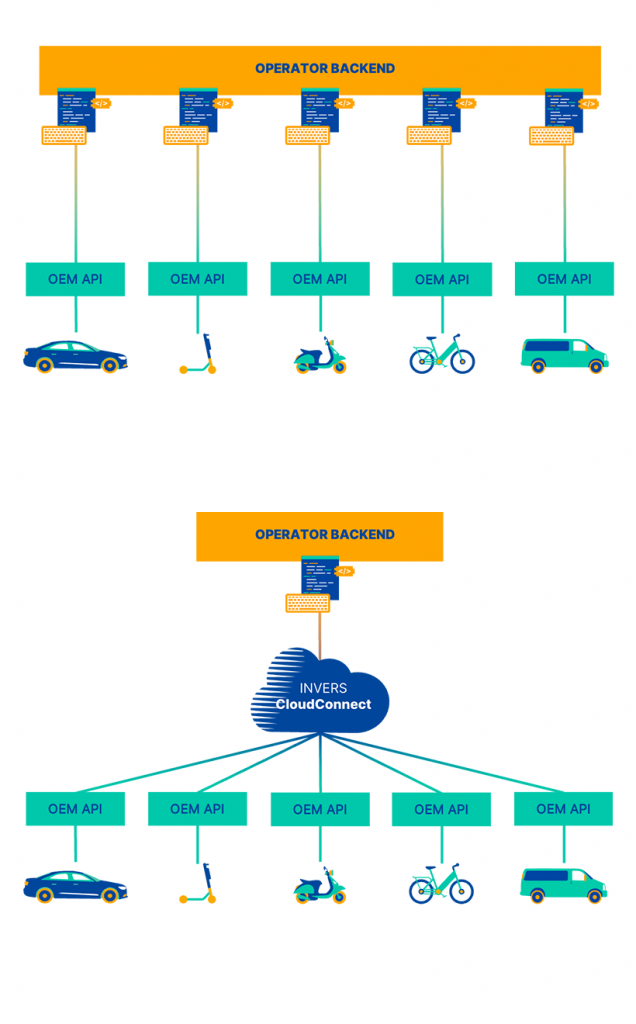
Whether cars, mopeds or e-bikes, this uniform standard allows operators to communicate with vehicles via the same API – INVERS OneAPI – which facilitates vehicle interaction and data exchange. All connected telematics models can be directly addressed and used, providing operators with the freedom to choose any vehicle without worrying about integration efforts. A further advantage of CloudConnect is the ability to access OEM’s professional APIs that make it possible to send vehicle commands and execute vehicle data analysis (a capability lacked by competing solutions that can only access consumer APIs). Ultimately, what this capability delivers is greater simplicity, reliability and flexibility – allowing operators to create more agile business models and more attractive fleets and services.
Looking ahead
Based on all these insights, trends and technological developments, we are expecting exciting times ahead. As the supply of purpose-built vehicles increases, the demand for new mobility options grows and fleets become more and more diverse, there will be promising business opportunities for all kinds of mobility services, including shared mobility. As a technology provider we are looking forward to ensuring these services will be more convenient and reliabe, no matter what vehicle or business model. Ultimately, this will mean that the use of shared vehicles becomes more attractive and affordable than ownership.
Author :

Bharath Devanathan
Chief Business Officer
INVERS GmbH
Bharath joined Invers in June 2021. He is responsible for business development, customer success and business partnerships. As a computer science graduate, Bharath brings relevant industry experience and a keen sense of developments in the international market, particularly from his previous work. At the Indian shared mobility operator Bounce, he was responsible for the business operations and the expansion of the fleet with electric vehicles.
Published in Telematics Wire

